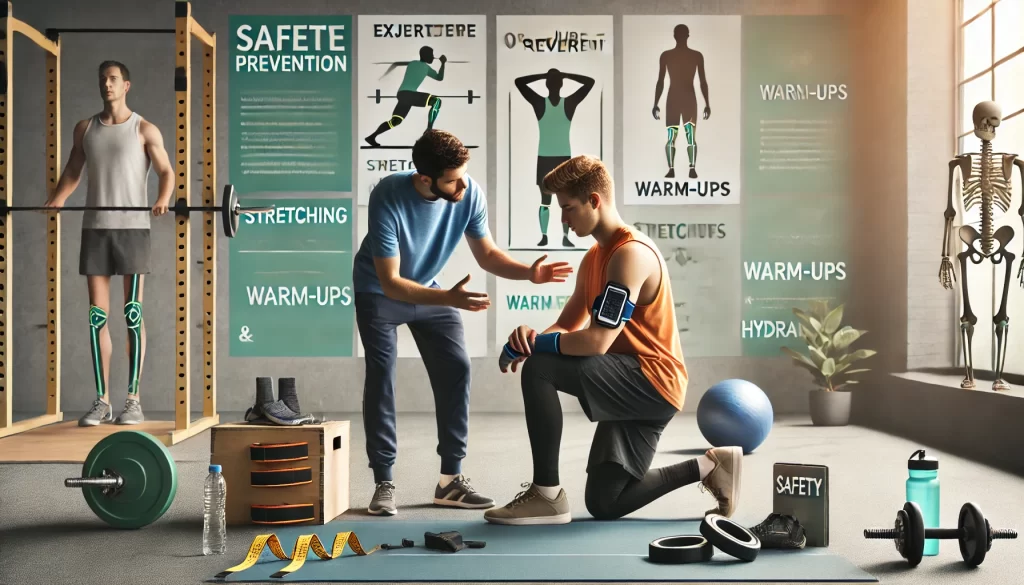
Exercise is essential for maintaining physical and mental well-being, but without proper precautions, it can lead to injuries that hinder progress and reduce motivation. Preventing injuries not only protects your body but also ensures long-term consistency in your fitness journey. This article offers practical advice to stay safe while working out.
Common Exercise Injuries and Their Causes
- Sprains and Strains: Overstretching or improper form can lead to ligament or muscle damage.
- Knee Pain: Often caused by overuse, weak supporting muscles, or incorrect alignment during exercises like squats or running.
- Back Injuries: Poor posture during exercises such as deadlifts or crunches can strain the spine or surrounding muscles.
- Shin Splints: Common in runners, often due to improper footwear or increasing intensity too quickly.
Understanding these common issues can help you adopt habits to prevent them.
Injury Prevention Basics
- Warm-Up: Start every session with a 5–10 minute warm-up to increase blood flow, loosen muscles, and prepare joints for activity. Examples include light jogging, jumping jacks, or dynamic stretches like leg swings.
- Use Proper Form: Incorrect technique is a leading cause of injuries. If you’re unsure, consider seeking guidance from a trainer or watching instructional videos.
- Progress Gradually: Avoid doing too much, too soon. Increase intensity, duration, or weight by no more than 10% per week.
- Wear the Right Gear: Proper footwear is crucial, especially for running or weightlifting. Choose supportive, activity-specific shoes to protect your joints and feet.
- Hydrate and Fuel Properly: Dehydration can cause muscle cramps and fatigue, increasing injury risk. Stay hydrated and eat nutrient-dense meals to fuel your workouts.
Exercise-Specific Tips
- Running:
- Alternate running surfaces (e.g., grass, track, or treadmill) to reduce impact on joints.
- Use proper running form: keep your shoulders relaxed, arms at a 90-degree angle, and land softly on your midfoot.
- Strength Training:
- Avoid lifting weights beyond your capacity; prioritize form over heavy loads.
- Engage your core to protect your back during exercises like deadlifts or squats.
- High-Intensity Interval Training (HIIT):
- Focus on controlled movements during high-impact exercises like burpees or jump squats.
- Rest adequately between sets to avoid fatigue-induced errors.
- Yoga and Stretching:
- Never force your body into a pose; progress gently to avoid overstretching.
- Use props like blocks or straps to support flexibility training.
Post-Workout Recovery
Recovery is as important as the workout itself. Proper recovery practices prevent overuse injuries and allow your body to rebuild stronger.
- Cool Down: Spend 5–10 minutes stretching after exercise to reduce muscle stiffness and improve flexibility.
- Rest Days: Incorporate at least one rest or active recovery day per week to let your muscles repair and grow.
- Massage and Foam Rolling: These techniques release tension in muscles and promote blood flow to speed up recovery.
- Sleep: Aim for 7–9 hours of quality sleep per night to support physical repair and mental focus.
Handling Minor Injuries
If you experience discomfort or minor injuries:
- R.I.C.E. Method: Rest, Ice, Compression, and Elevation can help reduce swelling and pain for acute injuries.
- Pain Signals: Listen to your body. If pain persists or worsens, stop the activity and seek medical advice.
- Modify Workouts: Substitute high-impact exercises with low-impact alternatives (e.g., swimming or cycling) while recovering.
When to Seek Professional Help
Some injuries require expert attention. Consult a doctor or physical therapist if:
- Pain is severe or lasts beyond a few days.
- You experience swelling, bruising, or reduced range of motion.
- There’s a “pop” or sharp pain during exercise, which may indicate a serious issue like a ligament tear.
Maintaining a Long-Term Injury-Free Routine
- Listen to Your Body: Fatigue, soreness, or unusual pain are signs that your body needs rest.
- Cross-Train: Diversify your activities to avoid overworking the same muscle groups.
- Invest in Training: A session with a certified trainer can teach proper techniques and identify potential weaknesses.
Conclusion
Preventing injuries is about exercising smarter, not harder. By warming up, practicing proper form, progressing gradually, and prioritizing recovery, you can stay active and healthy for the long haul. Remember, consistency and safety go hand in hand—protect your body to ensure you enjoy the lifelong benefits of fitness.

